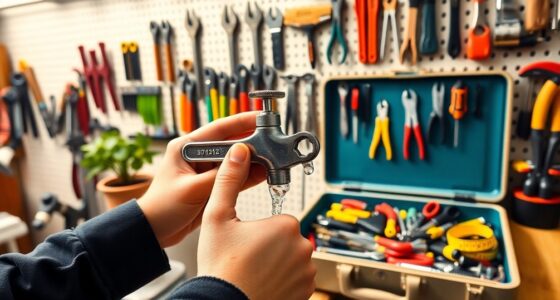To choose the right power tool for your DIY needs, start by evaluating your project’s size and complexity. Identify the materials you’ll work with, as different tools suit wood, metal, or concrete. Decide between corded for consistent power or cordless for convenience. Prioritize portability, ease of use, and safety features that align with your preferences. Don’t forget to budget wisely and maintain your tools for longevity. There’s more to discover that can help you make the best choice!
Key Takeaways
- Assess the project size and material type to determine necessary tool specifications, from basic cordless tools for small tasks to specialized tools for complex projects.
- Choose between corded for consistent power in heavy-duty tasks and cordless for portability, weighing your needs for stability versus mobility.
- Prioritize tools with ergonomic designs and safety features like guards and constant-pressure switches to enhance user comfort and prevent accidents.
- Budget effectively by identifying essential tools for frequent use and consider combo kits or second-hand options for cost savings without sacrificing quality.
- Organize tools with customizable storage solutions and research reputable brands to ensure durability and reliability in your DIY projects.
Understanding Your Project Requirements
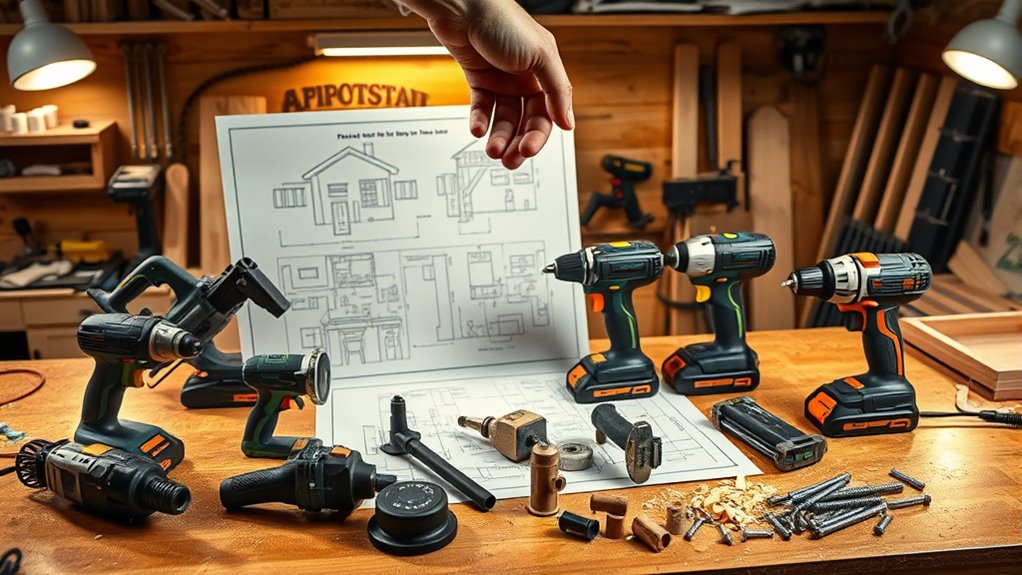
What do you need for your DIY project? Start by evaluating the size and complexity.
Small projects like replacing outlet covers only require basic tools, such as cordless screwdrivers.
If you’re tackling medium projects, like hanging shelves, you’ll need more robust tools like drill/drivers.
For complex tasks, specialized tools like jigsaws or miter saws become essential for precision cuts.
Consider portability, too; cordless tools are ideal for outdoor projects where mobility’s key.
Don’t forget your budget; manual tools like hammers and screwdrivers can be effective for simple tasks without breaking the bank.
Assessing Material Types and Tools
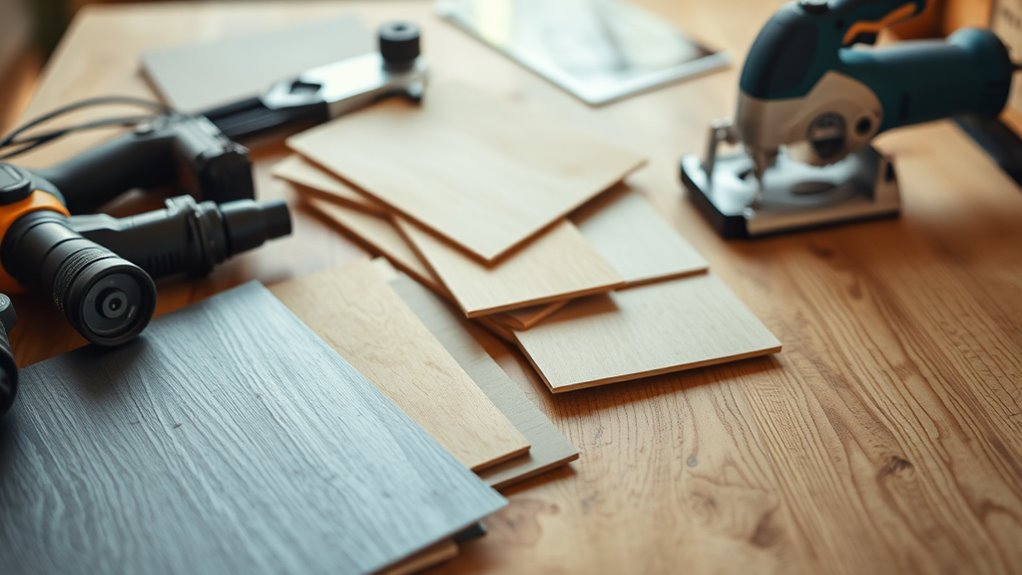
How can you guarantee your tools match the materials you’ll be working with? First, identify the material type. For wood, you’ll need tools like saws and sanders, while metalwork requires angle grinders and specialized drill bits. Consider the hardness and thickness of the material; harder materials demand more powerful tools. For instance, drilling into concrete necessitates robust tools with carbide-tipped bits. Additionally, using appropriate primer for the type of paint and surface can significantly enhance the adhesion and overall finish of your project. Furthermore, ensuring proper venting techniques can improve safety and efficiency when working with power tools that generate heat. Moreover, think about the desired finish—smooth surfaces need sanders or grinders. Incorporating smart technology can enhance precision and safety in your DIY tasks. Regular maintenance of your tools is essential for optimal performance, particularly for those used on modern toilet functionality to ensure they operate effectively. Always confirm your tools are suited for the task at hand, factoring in any special requirements like adhesives for plastics or composites. Furthermore, ensuring proper air quality control can enhance your overall project environment and comfort. Evaluating these elements will help you choose the right tools for a successful DIY project.
Evaluating Corded vs. Cordless Options
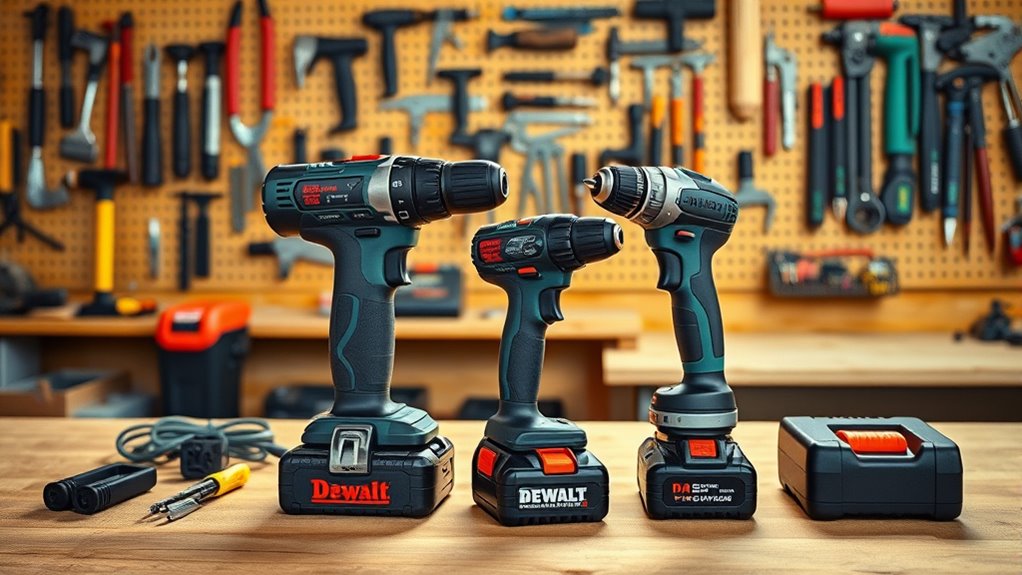
When deciding between corded and cordless power tools, which factors matter most to you?
If you prioritize consistent power output, corded tools are your best bet. They offer stable performance, making them ideal for heavy-duty tasks that require continuous operation without the risk of battery depletion. Corded tools typically deliver higher torque and maintain efficiency over time, reducing long-term maintenance costs. Additionally, just as with essential oils like eucalyptus oil, which acts as a powerful decongestant, corded tools can provide strong and reliable performance in demanding jobs. Regular maintenance, such as filter replacement, can also enhance the longevity of your tools. Furthermore, a well-maintained system can significantly improve energy efficiency, ensuring that your investment in tools pays off over time.
On the flip side, cordless tools might seem convenient, but keep in mind their higher initial costs and ongoing battery expenses. They can depreciate faster due to the need for battery replacements. Additionally, just as with air purifiers, proper maintenance of your tools, such as regular battery checks, can extend their lifespan and efficiency.
Portability and Ease of Use
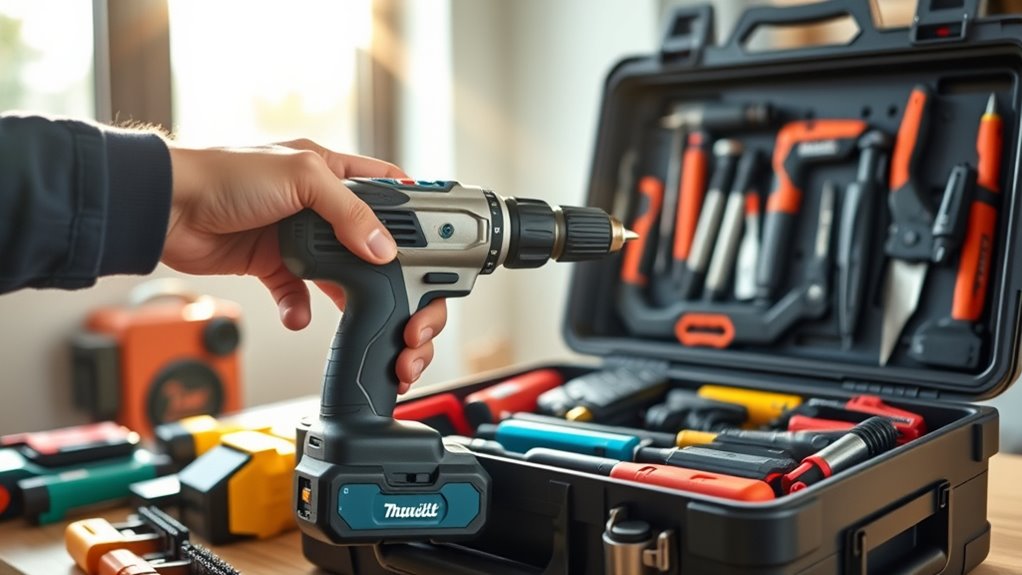
Choosing the right power tool goes beyond just corded or cordless options; portability and ease of use play a vital role in your overall experience.
Lighter tools with balanced designs reduce fatigue and enhance control, making them easier to handle during long projects. Opt for compact options that fit into tight spaces and are simple to transport. Many models, such as handheld airless paint sprayers, are designed specifically for effortless handling and convenience. Additionally, selecting tools with high suction power can significantly improve efficiency during your DIY tasks. For instance, tools like the Titan ControlMax 1700 Pro showcase advanced technology that enhances performance and finish quality. Choosing tools with advanced filtration systems can also help keep your workspace cleaner by reducing dust and allergens.
Cordless tools generally offer better portability, especially with interchangeable batteries that keep you working longer.
Ergonomic designs guarantee a secure grip and reduce strain, which is essential for comfort.
Finally, tools with intuitive controls and safety features simplify operation, allowing you to focus on your project without worrying about mishaps. Additionally, understanding common repairs can help you choose tools that best meet your specific DIY needs.
Prioritizing these factors will improve your DIY experience considerably.
Voltage Considerations for Power Tools
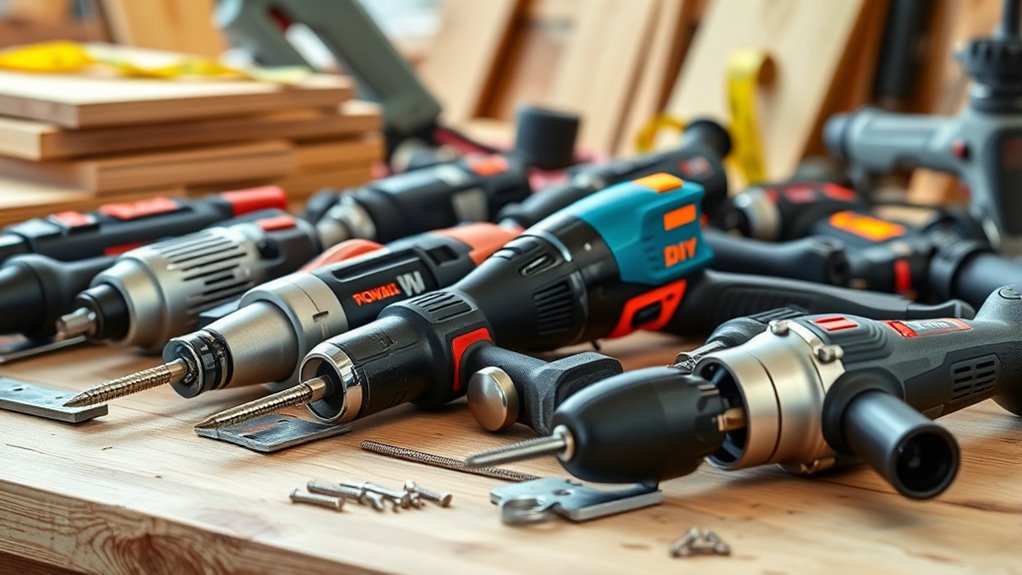
What voltage level should you consider for your power tools? When choosing, think about the tasks you’ll tackle.
For light-duty jobs like drilling, a 12V tool is sufficient, while an 18V tool works well for medium tasks like wood cutting. If you’re cutting metal, go for a 20V angle grinder. Understanding your investment goals can also help you choose tools that will provide the best value for your projects. Additionally, using tools with HEPA filters can help reduce airborne particles while you work in enclosed spaces. It’s important to note that emotional detachment can also occur in professional relationships, which can impact your overall productivity and satisfaction. Engaging in continuous improvement practices can enhance the efficiency and effectiveness of your tool usage.
Heavy-duty tasks, such as tree trimming, typically require a 36V reciprocating saw. Remember that higher voltage tools are generally more powerful but also heavier and pricier. Lower voltage tools may be easier to handle and pose fewer safety risks for beginners. Additionally, consider the high refresh rates offered by certain tools for enhanced performance in demanding applications. Ultimately, consider your specific needs, budget, and the type of projects you plan to undertake to find the right voltage for your power tools.
Safety Features to Look For
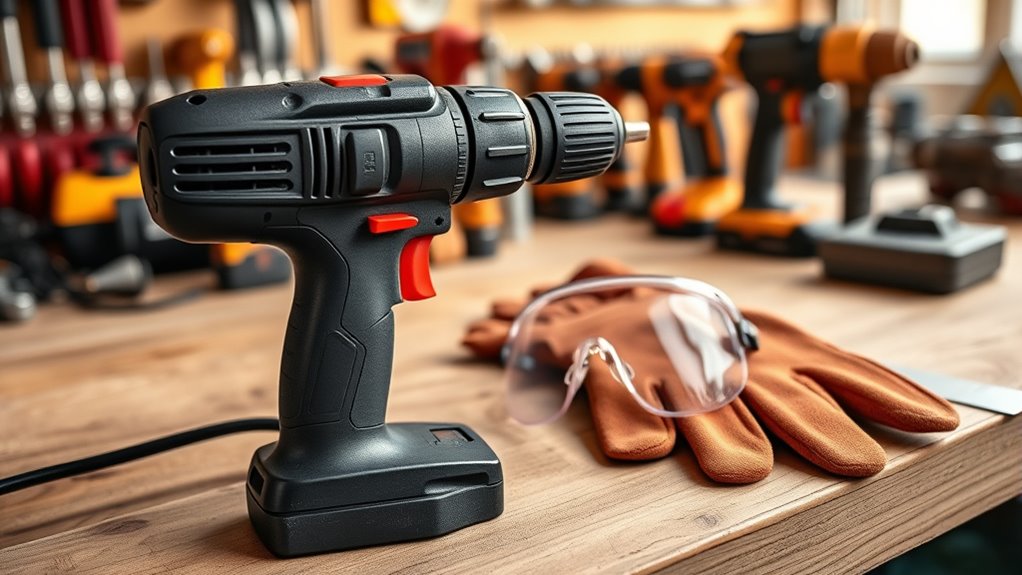
Power tools can make your DIY projects easier and more efficient, but guaranteeing your safety while using them is just as important as selecting the right voltage.
Look for tools with a constant-pressure switch that cuts off power when you release it, preventing accidental starts. Confirm they’ve proper grounding and good insulation to avoid electrical shocks. Additionally, using tools equipped with mechanical safety features is crucial for enhancing protection. Tools with AI-driven safety features are increasingly being developed to further reduce risks during operation. A tool’s versatility can also contribute to safer usage by allowing you to complete tasks with fewer tools, reducing the chance of accidents. For example, using tools with high-quality filters can enhance performance and reduce the likelihood of malfunctions.
Mechanical safety features like blade guards and trigger locks are essential for protection. Don’t forget personal protective equipment like safety glasses, gloves, and ear protection.
Always keep your work area clear and inspect tools regularly for damage. Finally, read the user manual and maintain proper hand positioning to enhance control and minimize risks. Additionally, consider using tools with built-in safety features to provide extra protection during your projects.
Stay safe while creating!
Budgeting for Power Tools

Budgeting for power tools is essential for any DIY enthusiast looking to maximize their investment. Start by identifying the essential tools you’ll use frequently, like a cordless drill or circular saw.
Allocate your budget based on the importance of each tool and how often you’ll use it. Consider long-term savings with versatile tools and those with battery sharing systems.
Look for combo kits, which can be more cost-effective, and don’t shy away from second-hand options to save money. Brands like Worx and Ryobi offer budget-friendly choices without sacrificing quality.
Keep an eye on sales and promotions to snag great deals, ensuring your tool collection meets your needs without breaking the bank.
Tool Maintenance and Longevity
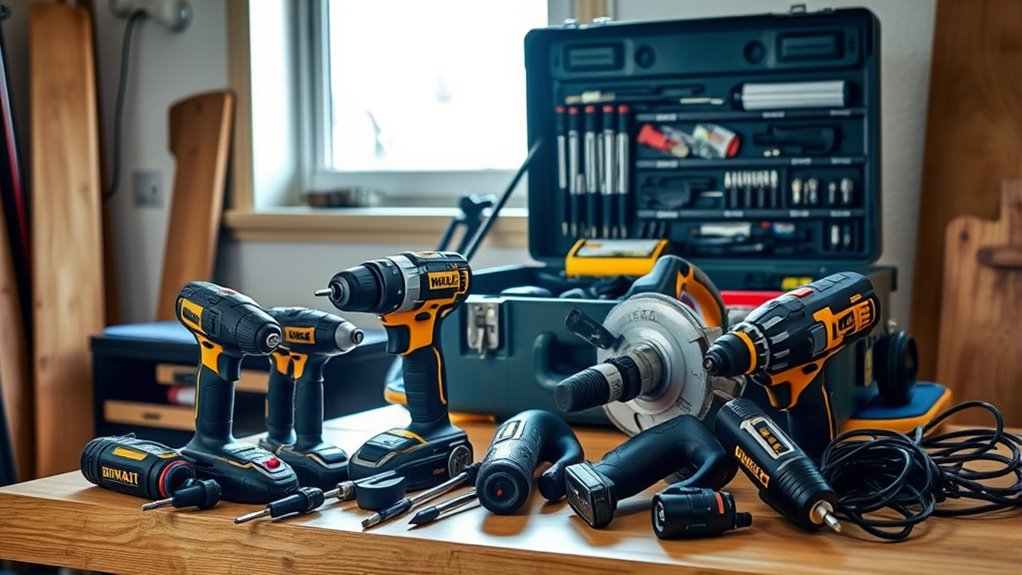
Maintaining your tools is essential for guaranteeing they perform at their best and last longer. Start by cleaning your tools after each use to prevent dirt buildup that can hinder performance.
Store them in a dry, clean environment, like toolboxes or pegboards, to avoid rust and damage. Regular lubrication of moving parts, as per manufacturer guidelines, helps reduce friction and wear.
Don’t forget to inspect tools frequently for signs of wear, such as dull blades or loose screws. Establish a regular maintenance schedule to guarantee consistent checks.
Space and Storage Solutions

Effective space and storage solutions are essential for any DIY enthusiast looking to optimize their workshop. Start by implementing customizable storage systems that adapt to your tools’ sizes. Use drawers with dividers to keep smaller power tools organized and easily accessible.
Construct budget-friendly plywood shelves for sturdy storage, utilizing vertical space with pegboards and hooks to keep floors clear. Position frequently used tools at eye level for efficiency. Consider using scrap wood or repurposed materials for unique, cost-effective organizers.
Group tools by type to streamline your workflow, and design storage for easy access. Finally, verify your layout enhances safety and workspace flow, allowing you to focus on your projects without clutter distractions.
Researching Brands and Quality
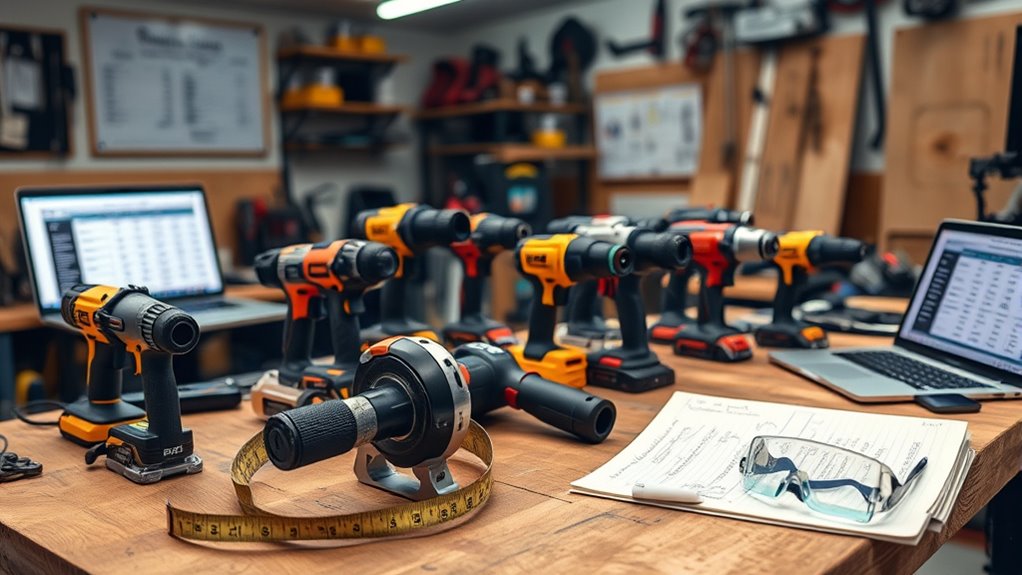
When you’re diving into DIY projects, researching brands and their quality can make a significant difference in your overall experience.
Start by exploring reputable brands like DeWalt, Milwaukee, and Ridgid, known for their durable designs and innovative technologies. Pay attention to specialized tools; for instance, Ridgid excels in piping and HVAC, while Bosch covers a broad spectrum of tasks.
Don’t overlook warranties—Ridgid offers lifetime warranties, showcasing confidence in their products. Customer reviews can also provide insights into performance and user satisfaction.
Finally, consider your budget; while some brands are mid to high-priced, others like Ridgid offer competitive pricing without sacrificing quality. Finding the right balance guarantees you choose tools that fit your DIY needs perfectly.
Frequently Asked Questions
What Are the Essential Accessories for Power Tools?
When you’re diving into power tools, you’ll want essential accessories to maximize your projects.
Drill bits and attachments help you tackle different materials, while saw blades guarantee precise cuts.
Don’t overlook router and sanding accessories for finishing touches, and miscellaneous items like clamps and safety goggles keep your workspace organized and safe.
With the right accessories, you’ll enhance your tool’s functionality and elevate your DIY experience.
How Do I Properly Clean My Power Tools?
Did you know that properly cleaned tools can last up to 30% longer?
To clean your power tools, first, unplug them and use compressed air to blow out debris.
Wipe surfaces with a damp cloth and scrub grime with steel wool.
For small areas, a toothpick works wonders.
Don’t forget to lubricate moving parts and store your tools in a dry place to prevent rust.
Regular maintenance keeps them in top shape!
What Is the Average Lifespan of Power Tools?
The average lifespan of power tools varies widely depending on the type and usage.
For instance, cordless drill drivers typically last about four years, while drills can endure up to fifteen years with proper maintenance.
Cordless saws and impact drivers usually last five to seven years.
Can I Use Power Tools for Both Indoor and Outdoor Projects?
“Don’t put all your eggs in one basket.”
You can definitely use power tools for both indoor and outdoor projects! Cordless tools offer the flexibility you need to move around freely, while corded tools provide reliable power for stationary tasks.
Just guarantee you choose tools with the right features, like ergonomic designs and safety measures, to make your work easier and safer, regardless of where you’re tackling your DIY projects.
Are There Specific Safety Certifications for Power Tools?
Yes, there are specific safety certifications for power tools.
You should consider taking hand and power tool safety training courses to guarantee you’re using tools safely. These certifications demonstrate your competence and often align with industry standards, which many employers require.
Additionally, some courses offer continuing education units, helping you stay updated on safety practices.
Conclusion
Choosing the right power tool isn’t just about picking what looks good—it’s about matching the tool to your unique DIY needs. By considering factors like project requirements, material types, and your budget, you can find the perfect fit. Remember, a well-chosen tool can be the difference between a successful project and a frustrating experience. So, why settle for less when you can empower your creativity with the right equipment? Your next project deserves the best, don’t you think?


